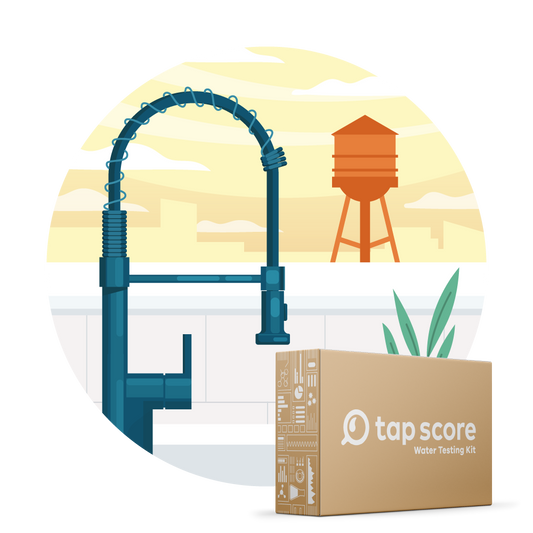
Quick Guide to Pathogens in Drinking Water
Our blog is written by real experts— not AI. Each guide is carefully reviewed and updated based on the latest research. Plus, with no affiliate links, you can count on unbiased insights you can trust.
Municipal water systems work hard to make our water safe to drink, and any time a water system detects a pathogen, customers are alerted immediately. At the same time, our tap water is not always 100% free from waterborne pathogens, which can form within your home distribution system or be a challenge for private wells. Unlike the disinfection processes that occur at water utilities, well water is not treated.
The following quick guide explores some of the more common waterborne pathogens found in drinking water. Some of them are only an issue following a natural disaster, like a flood or hurricane, but all of them can cause health issues if left undetected by a water test.
Table of Contents:
- Common Pathogens that Can Contaminate Drinking Water
- E. coli
- Legionella
- Campylobacter
- Salmonella
- Pseudomonas
- Giardia
- Cryptosporidium
- How to Protect Your Drinking Water from Pathogens
Common Pathogens that Can Contaminate Drinking Water

While most bacteria and microorganisms are relatively harmless, some definitely are not. A few of the most common waterborne microorganisms that can cause illness include:
- E. coli
- Legionella
- Campylobacter
- Salmonella
- Pseudomonas
- Giardia
- Cryptosporidium
Most of the time, public water systems experience outbreaks of waterborne pathogens after some unforeseen event, like a natural disaster. Water systems issue Do Not Drink or Boil Advisories in these cases.
Private well water contamination, however, is a more common occurrence. Regular testing and monitoring is key to making sure your well water is safe to drink.
Ultimate Guide to Well Water Contaminants
Whatever your water source, however, it’s a good idea to know the signs and symptoms of waterborne diseases.
E. coli in Drinking Water

Escherichia coli—more commonly referred to as E. coli—is a type of coliform bacteria that is found in the intestines of warm-blooded animals. E. coli is a large and varied group of bacteria, and most strains are harmless.[1] However, some strains can make you very sick.
Health Effects of E. coli in Water
If you consume E. coli contaminated water, symptoms from pathogenic infection typically appear within one to eight days (i.e., the incubation period). As there are a wide array of strains, your health may be impacted in a variety of ways.[2] One of the most common and dangerous waterborne strains of E. coli is E. coli 0157:H7. Symptoms of this strain may include:
- Nausea
- Vomiting
- Fever
- Abdominal pain
- Diarrhea
While symptoms can last anywhere from a few days to more than a week, 90% of people who contract E. coli 0157:H7 have a self-limited infection and their outcome is (generally) excellent.[3]
How to Test Your Water for E. coli Contamination
We recommend the following test:
Laboratory testing is more precise than DIY, presence/absence strips. Testing for E. coli bacteria is especially recommended for people served by a private well. The presence of E. coli in drinking water suggests that potentially harmful bacteria are entering your water supply and should be addressed immediately.
Legionella Bacteria and Drinking Water Safety
Legionella is a genus of pathogenic bacterium. Legionella is harmless for most people and typically causes disease in people with compromised immune systems. However, Legionella pneumophila can cause Legionnaires’ Disease, a severe (and often lethal) form of pneumonia.[4]
The bacterium occurs naturally in freshwater environments, but becomes a serious health concern when it grows and/or spreads in constructed water systems, like plumbing and distribution systems. If water has been stagnant in your pipes or water heater for an extended period, Legionella may be a concern.
Legionella: What You Need to Know
Symptoms of Legionnaires’ Disease from Contaminated Water
People can contract Legionnaires’ disease if they breathe in (tiny) droplets of contaminated water in the air that contain the bacteria. Typically, the disease is not spread person to person. It is estimated that each year in the United States, between 10,000 and 18,000 people are infected with Legionella bacteria.[5] Symptoms of the disease typically present as pneumonia and include:
- High fever
- Chills
- Cough
- Headaches
- Diarrhea
A study that examined outbreak survivors in the months following the infection, many showed persistent fatigue (75%), neurologic symptoms (66%), and neuromuscular symptoms (63%).[6]
How to Test Your Water for Legionella
You can test for Legionella in your water with the following test:
Legionella bacteria is most frequently found in air-conditioning units, faucets, pools, spas, showers and other water-related devices. Testing for Legionella with a certified laboratory is recommended if someone in your home has contracted Legionnaires’ Disease.
Campylobacter in Drinking Water
Campylobacter jejuni is a species of bacteria that can cause an illness called campylobacteriosis that primarily includes diarrhea. People are typically exposed to Campylobacter through contaminated food, but contaminated water is also a possible exposure route.[13]
Campylobacter can enter certain water sources, like private wells, via contamination with feces from infected people or animals—specifically poultry. Exposure to very few organisms can cause illness.
Symptoms of Campylobacteriosis
Those infected with C. jejuni often experience symptoms of campylobacteriosis within two to five days of exposure. While some infected people show no signs at all, most infected people experience symptoms for about seven days.[14] These symptoms may include:
- Diarrhea (can be bloody)
- Fever
- Abdominal cramps
- Nausea
- Vomiting
Because most Campylobacter infections are self-limiting, they are usually not treated with antibiotics—although antibiotics may help shorten the duration of symptoms.
How to Test Your Water for Campylobacter
You can test for Campylobacter in your water with the following test:
You may consider testing for Campylobacter if you or others in your household experience symptoms and have poultry on your property. Remember to keep animal housing areas and feedlots at least 50-100 feet away from a water well system.
Salmonella in Drinking Water

Salmonella is a genus of bacteria that typically lives in animal and human intestines, and is spread through fecal-oral contact. The most frequent way humans become infected is through the consumption of contaminated food or water.[7] Water may contain Salmonella bacteria when:
- A well has been contaminated with feces from an infected human or animal
- Sewage overflows or septic system malfunction
- Polluted stormwater or agricultural runoff contaminates the water source
Salmonella are typically divided into two groups: typhoidal and non-typhoidal. Non-typhoidal Salmonella serotypes (various types) typically cause milder GI illnesses.
Symptoms of Salmonella Infection
Some people infected with Salmonella bacteria show no signs. However, most develop symptoms within eight to 72 hours. Possible symptoms include:
- Diarrhea (may have blood or mucus)
- Fever
- Abdominal cramps
- Nausea
- Vomiting
These symptoms tend to last between two and seven days—although it may take several months before bowels return to normal.[8] Generally, most healthy people recover without specific treatment.
How to Test Your Water for Salmonella
We recommend the following water test for Salmonella:
Testing your drinking water for Salmonella is suggested for those who have recently contracted a salmonella infection and are also concerned about contamination of their water supply from nearby septic leaks or agricultural runoff.
Pseudomonas in Drinking Water
Pseudomonas is a genus of bacteria commonly found in soil and water. One species in particular, Pseudomonas aeruginosa, is known for its ability to thrive in moist environments and resist common disinfectants. P. aeruginosa can lead to infections in the blood, lungs, urinary tract, or other parts of the body, particularly in healthcare settings.[9]
In drinking water systems outside healthcare settings, it can persist by forming biofilms on plumbing surfaces. Contamination may occur when:
- Biofilms form on the inside of pipes, faucets, or water tanks
- Water stagnates in underused plumbing systems
- Plumbing materials support microbial growth (e.g., certain plastics or rubber seals)
- Disinfectant levels are insufficient to suppress microbial presence
While healthy individuals are generally not at risk, exposure through aerosolized water (e.g., showers, humidifiers) or contact with broken skin can occasionally cause minor infections.
Symptoms of Pseudomonas Infection
Most people exposed to Pseudomonas through drinking water will not become ill. However, some may experience symptoms, especially if they have weakened immune systems or are exposed through wounds or aerosolized water. Potential symptoms of Pseudomonas infection include:
- Skin rashes (especially after exposure to hot tubs or pools)
- Ear infections ("swimmer’s ear")
- Eye infections
- Respiratory issues in vulnerable individuals
These infections are typically mild and treatable, though more serious illness can occur in immunocompromised populations.
How to Test Your Water for Pseudomonas
We recommend the following water test for Pseudomonas:
Testing your drinking water for Pseudomonas is recommended if you’ve experienced recurrent skin, ear, or respiratory infections, especially after water exposure, or if your plumbing system has been stagnant or poorly disinfected.
Giardia lamblia Contamination in Drinking Water
Giardia lamblia is a parasite that can be found worldwide and in every region of the United States. However, it is most prevalent in areas with very poor sanitation. Once a person consumes Giardia in drinking water, the parasite lives in his or her intestines and is passed in feces. Millions of Giardia parasites can be released in a single bowel movement and they can survive outside of the body for months due to their protective outer shell.[10]
Giardia can be found in streams and lakes, and their long lifespan in the environment increases the likelihood that they can enter into water systems (including municipal water supplies).
Symptoms of Giardia lamblia Infection
Giardia causes an intestinal infection—giardiasis—that can be transmitted through consuming contaminated food or water, or through fecal-oral transmission. Symptoms of giardiasis include:
- Watery diarrhea that may alternate with soft, greasy stools
- Fatigue
- Abdominal cramps
- Gas
- Nausea
- Weight loss
These symptoms may last for two to six weeks, but in some people they last far longer or recur.[10] In people whose symptoms clear up, they still may experience intestinal problems well after the parasites are out of their system. While several drugs may be effective against the parasites, not everyone responds to them.
Testing for Giardia
Testing your drinking water for Giardia is the best way to pinpoint the source of giardiasis infection. However, due to the large water volume required, it can be expensive to test for and is only recommended if you have specific reasons to be concerned about Giardia and/or Cryptosporidium. We’ve paired the two: See “Cryptosporidium” below for tests.
Cryptosporidium in Drinking Water
Commonly known as “Crypto,” Cryptosporidium is a parasite that is protected by an outer shell which allows it to survive outside of the body for an extended period of time. The shell also makes it very resistant to chlorine disinfection. Due to its resilience, Crypto is most commonly spread in water (both drinking water and recreational water) making it the leading cause of waterborne disease among humans in the United States.[11]
Signs of Cryptosporidium Infection
Cryptosporidium in drinking water causes a diarrheal disease—cryptosporidiosis—which can be long lasting. While some people who drink Cryptosporidium-contaminated water show no symptoms at all, others may see symptoms on and off for more than 30 days.[12] Symptoms of cryptosporidiosis include:
- Watery diarrhea
- Stomach cramps or pain
- Dehydration
- Nausea
- Vomiting
- Fever
- Weight loss
Test Your Water for Cryptosporidium
Due to the large volume required for testing, we recommend you test for Cryptosporidium together with Giardia. We recommend the following test if you have specific reasons to be concerned about Crypto or Giardia contamination:
How to Protect Your Drinking Water from Pathogens
While this list covers a few potential, dangerous microorganisms in your drinking water, it is important to remember that your tap water is (generally) safe. Public water utilities work hard to ensure that dangerous bacteria, algae, fungus, and other microbes are not only removed from the supply, but also gets treated with enough disinfecting power to address any pathogens downstream.
While bacterial issues in city water are rare, if you get your water from a private well, spring, any other non-utility source, or are traveling, you may be at higher risk for encountering waterborne microbes. Private well owners should pay attention to risk factors like poor maintenance or weather events, and any signs of contamination.
Frequently Asked Questions About Pathogens in Drinking Water
How Do I Know if My Drinking Water Is Contaminated with Pathogens?
Often, contaminated water may not look, taste, or smell unusual. Testing your water is the only reliable way to detect harmful pathogens.
What Are the Symptoms of Drinking Water Contaminated with Pathogens?
Symptoms can vary but often include nausea, diarrhea, vomiting, fever, and stomach pain. Severe cases can lead to dehydration or more serious health issues, especially in children and the elderly.
How Can I Test My Water for Pathogens?
Mail-to-lab testing kits like Tap Score's Total Microbiology Water Test can detect common bacteria and viruses. We recommend testing for total microbiology as a follow-up to a more entry-level test or if there are clear signs of waterborne illness in your area. All of the test kits referenced above will test for the specific pathogen in question.
How Can I Prevent Pathogenic Contamination of my Water?
Prevention strategies include using certified water filters, boiling water during boil advisories, and regular testing if you use a private well.
Can Charcoal Filters Remove Bacteria and Viruses?
Charcoal, or activated carbon, filters are typically not effective in removing bacteria and viruses. And, in fact, they are generally not recommended for use with water that has a chance of being contaminated with bacteria or viruses.
Read More
▾Sources and References
▾- E. coli (Escherichia coli) | E. coli
- The Who’s Who of E. coli Strains
- Is E. coli Infection Contagious? Signs, Symptoms, Treatments & Causes
- Legionnaires Disease History, Burden, and Trends
- What Is Legionnaires' Disease
- Health-related quality of life and posttraumatic stress disorder among survivors of an outbreak of Legionnaires disease
- Salmonella and Drinking Water from Private Wells | Wells | Private Water Systems | Drinking Water | Healthy Water
- Salmonella infection - Symptoms and causes
- About Pseudomonas aeruginosa
- Giardia and Drinking Water from Private Wells | Wells | Private Water
- Cryptosporidium | Drinking Water | Healthy Water
- Symptoms of Crypto | Cryptosporidium ("Crypto") | CDC
- About Campylobacter infection
- Symptoms of Campylobacter Infection







